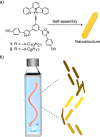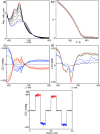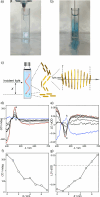Vortex-Flow-Directed Chiral Macroscopic Ordering of Platelet Nanostructures Formed via the Supramolecular Assembly of Platinum Complexes with Bis(phenylisoxazolyl)benzene
- PMID: 40802790
- PMCID: PMC12395485
- DOI: 10.1021/jacs.5c03761
Vortex-Flow-Directed Chiral Macroscopic Ordering of Platelet Nanostructures Formed via the Supramolecular Assembly of Platinum Complexes with Bis(phenylisoxazolyl)benzene
Abstract
To understand the vortex flow-directed circular dichroism (CD) effect observed in homogeneous solutions containing supramolecular structures, the macroscopic order formed by supramolecular structures oriented within a flow must be visualized. In this study, a bis(phenylisoxazolyl)benzene-attached platinum complex was found to self-assemble to form uniform anisotropic platelet nanostructures that are oriented within a flow, thereby generating a chiral macroscopic order that is responsible for CD and linear dichroism (LD) effects only in the vortex flow regime. Cooperative self-assembly of a bis(phenylisoxazolyl)benzene-attached platinum complex via controlled supramolecular polymerization produced anisotropic platelet nanostructures with a narrow polydispersity index. The orientational order parameter of the nanostructures correlated with the flow velocity; thus, the nanostructures were oriented along the flow direction. Furthermore, the vortex flow of the dilute nanostructure solution broke the symmetry of the flow, thereby generating a chiral macroscopic order. As a result, CD and LD effects were observed in the vortex flow regime of the dilute nanostructure solution. These results can be generalized to the formation of chiral macroscopic order in solutions containing anisotropic nanostructures.
Figures








Similar articles
-
Prescription of Controlled Substances: Benefits and Risks.2025 Jul 6. In: StatPearls [Internet]. Treasure Island (FL): StatPearls Publishing; 2025 Jan–. 2025 Jul 6. In: StatPearls [Internet]. Treasure Island (FL): StatPearls Publishing; 2025 Jan–. PMID: 30726003 Free Books & Documents.
-
Electrophoresis.2025 Jul 14. In: StatPearls [Internet]. Treasure Island (FL): StatPearls Publishing; 2025 Jan–. 2025 Jul 14. In: StatPearls [Internet]. Treasure Island (FL): StatPearls Publishing; 2025 Jan–. PMID: 36251838 Free Books & Documents.
-
Topotecan, pegylated liposomal doxorubicin hydrochloride and paclitaxel for second-line or subsequent treatment of advanced ovarian cancer: a systematic review and economic evaluation.Health Technol Assess. 2006 Mar;10(9):1-132. iii-iv. doi: 10.3310/hta10090. Health Technol Assess. 2006. PMID: 16545208
-
Cost-effectiveness of using prognostic information to select women with breast cancer for adjuvant systemic therapy.Health Technol Assess. 2006 Sep;10(34):iii-iv, ix-xi, 1-204. doi: 10.3310/hta10340. Health Technol Assess. 2006. PMID: 16959170
-
Anterior Approach Total Ankle Arthroplasty with Patient-Specific Cut Guides.JBJS Essent Surg Tech. 2025 Aug 15;15(3):e23.00027. doi: 10.2106/JBJS.ST.23.00027. eCollection 2025 Jul-Sep. JBJS Essent Surg Tech. 2025. PMID: 40821726 Free PMC article.
References
-
- Hopfinger E. J., van Heijst G. J. F.. Vortices in Rotating Fluids. Annu. Rev. Fluid. Mech. 1993;25:241–289. doi: 10.1146/annurev.fl.25.010193.001325. - DOI
-
- Kehoe D. K., McCarthy J., Gough J. J., Bradley A. L., Gun’ko Y. K.. Macroscopic Vortex-Induced Optical Activity in Silver Nanowires. J. Phys. Chem. C. 2019;123:15307–15313. doi: 10.1021/acs.jpcc.9b02965. - DOI
LinkOut - more resources
Full Text Sources
Research Materials
Miscellaneous

